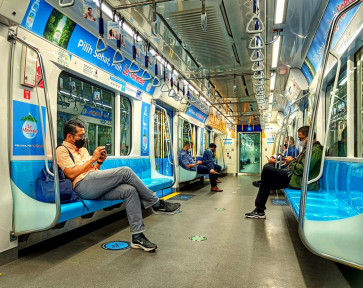Popular Reads
Top Results
Can't find what you're looking for?
View all search resultsPopular Reads
Top Results
Can't find what you're looking for?
View all search resultsBarata Sena: Exploring the art of furniture
(JP/Ganug Nugroho Adi)âNo wood is inferior
Change text size
Gift Premium Articles
to Anyone
(JP/Ganug Nugroho Adi)
'No wood is inferior. All kinds of wood have unlimited potential for exploitation. Don't ever think that teak is superior,' said Barata Sena, a wood craft artist from Surakarta, otherwise known as Solo, Central Java, who has created various non-teak works and furniture.
Barata never shuns cracked, broken or termite-infested wood either. On the contrary he simply benefits from the wood's condition to produce attractive and surprising artistic creations.
'Those engaged in woodworking usually avoid the use of wood already infested by termites. I'm different. I make explorations because artistic work depends on knowledge rather than raw materials alone,' he said.
Barata first used termite-stricken wood to create spectacular products after finding a supply of wood he had stored infested by the insects.
Despite the partial damage he discovered captivating textures, which prompted him to experiment by leaving several pieces of furniture like tables, chairs and cabinets in termite-infested areas.
Every week he noted the developments taking place and changed the positions of the furniture to obtain the desired effects. After a month, the originally smooth furniture became unique masterpieces.
'Parts of the wood consumed by termites turned into very artistic textures. For me, the beauty of the carving produced by termites remains unrivaled by men's handiwork,' said Barata, who describes the termites, ants and bugs as co-creators.
Apart from using insects, Barata has also explored woodworking by imitating the process of charcoal production. He boldly plunged a number of furniture pieces into a pit in the ground and scorched them.
As the furniture was lifted from the pit it had become blackened with astounding decorations of exotic grayish ripples in rhythmic patterns. When the charred furniture pieces were displayed, they sold at surprisingly high prices.
'By coating them with a variety of chemicals, the partially burned furniture becomes more solid and won't soil one's hands with soot when touched,' said Barata, a design graduate from the city's Indonesian Arts Institute (ISI).
Barata's works have indeed gone beyond standard forms of woodworking and instead of being confined to conventional furniture; he has also been inspired by various objects found in daily life around him.
In 2011 for instance, he held his 'Jalan Kayu' (Way of the Wood) exhibition at Balai Soedjatmoko, Solo, featuring wood-based fashion products such as women's undergarments, tank tops, scarves, kebaya (long-sleeved blouses), vests and shoes.
Barata is very meticulous about his fashion works, applying a high carving technique and working with great accuracy in handling clothing ornaments, seam layers and buttons on wood with a thickness of 3-5 millimeters.
Two years later Barata appeared with a display entitled 'Setimbang' (Balanced) at the Galeri Rumah Rempah, Colomadu, Karanganyar, Solo. Unlike the previous show, this time he presented furniture creations in a different perspective.
Notwithstanding his reference to furniture, what he displayed were unconventional furnishings. Barata reconstructed cabinets, cupboards, tables and chairs into new shapes. Some of them in fact lost their original functions, while others retained their usefulness.
There were cabinets in a sloping position each standing on two legs, with the other two legs distanced from the floor. But their shelves were made parallel to the floor so as to retain their original purpose as storage racks.
'I call these works art furniture, in which design esthetic takes priority over function,' explained Barata in his residence in the Jajar area, Laweyan, Solo.
Born into a modest family, Barata claimed his college studies were only to meet his parents' wishes. The design department he chose was also based on practical reasons rather than thorough calculations. 'I happened to be fond of drawing. It was my only motivation to study design,' he said.
After three years, Barata was disappointed by the dichotomy suggested by his campus between pure art and design. 'This dichotomy remains to this date. Pure art is always regarded as superior, producing specialist artists, while design is only for skilled craftspeople,' he remarked.
As a new graduate, Barata had a brief stint as a salesman before entering the woodcraft business by working with a housing development company in Jakarta.
'I was tasked with designing the interior of houses and filling their rooms with furniture. At first we ordered furniture from Jepara, Central Java. But later I got the idea of building the furnishings ourselves,' said the father of two.
That was the turning point of Barata's creative process of artistic woodworking. He started producing various pieces of furniture to fit out the house interiors, to the satisfaction of his customers.
When the company was making headway, Barata quit and returned to Solo to start his own business. Later he began to set aside his income from furniture sales for the creation of artistic wood products. 'I still produce ordinary furniture because it sells quickly and its proceeds are partly used to fund my art furniture making,' added Barata.
While designing art furniture, Barata also improved his knowledge over the years by conducting research into wood, with the general conclusion that wood qualities are determined by the soil in which trees grow, as contained in his book, Jalan Kayu.










